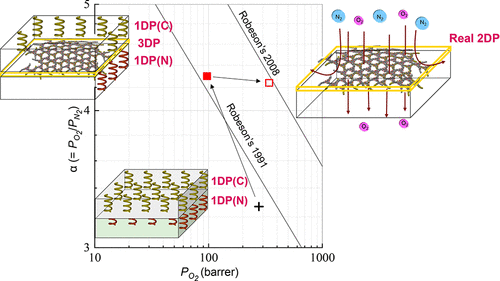当前位置:
X-MOL 学术
›
ACS Mater. Lett.
›
论文详情
Our official English website, www.x-mol.net, welcomes your
feedback! (Note: you will need to create a separate account there.)
Synthesis and Permselectivity of a Soluble Two-Dimensional Macromolecular Sheet by Solid–Solid Interfacial Polycondensation Followed by Chemical Exfoliation
ACS Materials Letters ( IF 9.6 ) Pub Date : 2020-08-07 , DOI: 10.1021/acsmaterialslett.0c00178 Yanqing Qu 1 , Xiaoyu Du 2 , Kehan Cheng 2 , Yu Zang 1 , Liang Xu 1 , Ken-ichi Shinohara 3 , Masahiro Teraguchi 2 , Takashi Kaneko 2 , Toshiki Aoki 2
ACS Materials Letters ( IF 9.6 ) Pub Date : 2020-08-07 , DOI: 10.1021/acsmaterialslett.0c00178 Yanqing Qu 1 , Xiaoyu Du 2 , Kehan Cheng 2 , Yu Zang 1 , Liang Xu 1 , Ken-ichi Shinohara 3 , Masahiro Teraguchi 2 , Takashi Kaneko 2 , Toshiki Aoki 2
Affiliation

|
Two-dimensional (2D) network polymers with nano-sized pores are generally insoluble, and therefore, it is difficult to determine their molecular structures and to fabricate their membranes. Soluble 2D network polymer membranes with angstrom-sized pores and thicknesses have not been reported. Herein, novel soluble 2D macromolecular sheets with angstrom-sized pores (24.6 Å) and thickness (3.4 Å) are synthesized by solid–solid interface polycondensation in laminated membranes of two cis–cisoid poly(imino-containing phenylacetylene)s followed by highly selective photocyclic aromatization (SCAT). First, a two-layered laminated polymer membrane that is self-supporting is prepared, and solid–solid interfacial polycondensation is performed. The insoluble three-dimensional (3D) network polymer layer formed is isolated by removing the soluble unreacted polymer layers. Finally, a SCAT reaction is carried out by irradiation of visible light on the insoluble 3D membrane to produce a soluble 2D macromolecular sheet. The precise 2D molecular structure can be displayed, such as the degree of polymerization, thickness, fraction of rings (pores), and pore size, estimated by GPC, AFM, 1H-NMR, IR, and XRD, because the macromolecule is soluble. Composite membranes containing the 2D macromolecular sheet show good oxygen permselectivity exceeding the Robeson upper line, possibly because the angstrom-sized pores and thicknesses produce high oxygen permselectivity without suppressing the permeability.
中文翻译:

固-固界面缩聚后化学剥落法合成可溶性二维高分子片材及其通透性
具有纳米级孔的二维(2D)网络聚合物通常是不溶的,因此难以确定其分子结构和制造其膜。尚未报道具有埃大小的孔和厚度的可溶2D网络聚合物膜。本文中,通过在两个顺式-cisoid聚(含亚氨基的苯基乙炔)的叠层膜中进行固-固界面缩聚,然后进行高度选择性的合成,合成了具有埃大小的孔(24.6Å)和厚度(3.4Å)的新型可溶性二维高分子片材。光环芳构化(SCAT)。首先,制备两层自支撑的层压聚合物膜,然后进行固-固界面缩聚反应。该不溶通过除去可溶的未反应的聚合物层来分离形成的三维(3D)网络聚合物层。最后,通过在不溶性3D膜上照射可见光来进行SCAT反应,以产生可溶性2D大分子片。由于大分子是可溶的,因此可以显示精确的二维分子结构,例如聚合度,厚度,环(孔)的比例和孔径(通过GPC,AFM,1 H-NMR,IR和XRD估算)。包含2D大分子片的复合膜显示出超过Robeson上限的良好的氧渗透选择性,这可能是因为埃大小的孔和厚度在不抑制渗透性的情况下产生了高的氧渗透选择性。
更新日期:2020-09-08
中文翻译:

固-固界面缩聚后化学剥落法合成可溶性二维高分子片材及其通透性
具有纳米级孔的二维(2D)网络聚合物通常是不溶的,因此难以确定其分子结构和制造其膜。尚未报道具有埃大小的孔和厚度的可溶2D网络聚合物膜。本文中,通过在两个顺式-cisoid聚(含亚氨基的苯基乙炔)的叠层膜中进行固-固界面缩聚,然后进行高度选择性的合成,合成了具有埃大小的孔(24.6Å)和厚度(3.4Å)的新型可溶性二维高分子片材。光环芳构化(SCAT)。首先,制备两层自支撑的层压聚合物膜,然后进行固-固界面缩聚反应。该不溶通过除去可溶的未反应的聚合物层来分离形成的三维(3D)网络聚合物层。最后,通过在不溶性3D膜上照射可见光来进行SCAT反应,以产生可溶性2D大分子片。由于大分子是可溶的,因此可以显示精确的二维分子结构,例如聚合度,厚度,环(孔)的比例和孔径(通过GPC,AFM,1 H-NMR,IR和XRD估算)。包含2D大分子片的复合膜显示出超过Robeson上限的良好的氧渗透选择性,这可能是因为埃大小的孔和厚度在不抑制渗透性的情况下产生了高的氧渗透选择性。











































 京公网安备 11010802027423号
京公网安备 11010802027423号